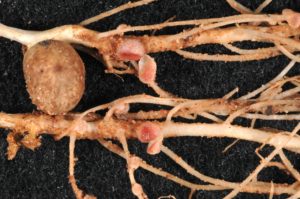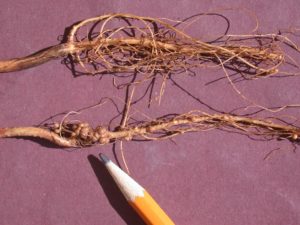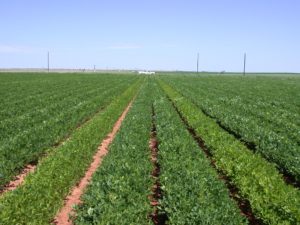Dr. Calvin Trostle, Extension Agronomy, TAMU Dept. of Soil & Crop Sciences, Lubbock, (806) 746-6101, ctrostle@ag.tamu.edu;
Dr. Emi Kimura, Extension Agronomy/State Extension Peanut Specialist, TAMU Dept. of Soil & Crop Sciences, Vernon, (940) 552-9941, emi.kimura@ag.tamu.edu
June 6, 2019
Note: The following comments address field observations primarily for the Texas High Plains peanut production region but are applicable to other Texas regions as well. We discuss other legume crops in the document as well.
Legumes are a valuable asset in any Texas crop rotation. They offer a potential contrast of susceptibility with the more likely disease and insect threats in other crops. Also—though often incorrectly assumed—legumes offer significant potential nitrogen (N) fixation to the existing crop with potential improved soil N status for the subsequent crop. There is one important caveat: legume and N-fixation benefits can only occur IF the roots are infected by a crop-specific bacterial strain of either Rhizobium or Bradyrhizobium, which either you applied or may already be present in the soil.
This bacterial infection of the root leads to nodulation. The bacteria survive and thrive inside these root nodules, visibly showing a pink or red color (Fig. 1). That means fixation of nitrogen in the air (an N2 molecule, which makes up about 78% of the atmosphere) is converted into a form the plants can use. This is the least costly form of nitrogen you can “apply” to your legume crop.
We will save information about effective use and application of N-fixing inoculants for a RowCrops NewsLetter in spring 2020. That will include discussion of choosing crop-specific inoculants, what form they are (the potential benefit declines from liquid to granular to seedbox powder forms), and ensuring accurate application and placement of the inoculant with the seed.
Assessing Nodulation in 2019 Texas Peanuts
We are approaching the time in mid-June after peanut planting in the Texas High Plains when peanut growers should check their taproot Bradyrhizobium nodulation. Scouting 5 to 6 weeks after planting assesses early nodulation in advance of possible decisions about applying mid-season N, and if so, how much N. You might find it surprising we even mention applying N
Fig. 1. Sliced Bradyrhizobium nodules on peanut demonstrate pink and red color indicating active fixation of nitrogen from the air.
fertilizer to a legume, but this possibility does occur. Nitrogen applications are almost certain if you recognize soon enough you have few or no active nodules on the roots. This applies to peanuts, soybean, peas and beans, guar, alfalfa, etc.
Scout your nodules!
Farmers, crop consultants, and supplier support staff scout field crops for insects and disease. We have learned we need to “scout for nodules” in our legume crops as well. Of course, this is a different situation compared to a pest. But if you applied an inoculant to your legume crop seed at planting and later find little to no nodulation, this is important for two reasons. First, of immediate concern, you are not getting the nitrogen nutrition you may have expected for your crop. Thus, fertilizer N may be needed to obtain your yield potential. Second, if you have no nodules then we need to understand why (wrong inoculant, expired inoculant, improper application, inoculant introduced into hot dry soils where the bacteria did not survive long enough to infect the roots, etc.).
Use a shovel to dig (do not pull, that can strip nodules off) several plants from different rows and field locations. The ideal situation is when you may also have a few rows with no inoculant applied to the seed. Then you could truly see if and how much nodulation benefit you may have. For any legume crop, inoculated or not, if nodulation is deemed poor, nothing can be done to increase nodulation in the current crop. In West Texas peanuts 20 to 25% of fields annually may be undernodulated, or worse, have only a few nodules per plant. Poor Bradyrhizobium nodulation calls for supplemental N to achieve desired yield potential. Therefore, early scouting is recommended. We need to know which field, for example peanuts, are not nodulating early in the cropping season.
Extension assessment of many peanut fields in the Haskell, Comanche, Atascosa, and Frio Counties typically have nodules all over the lateral roots suggesting a source of nodulating bacteria in the soil. These lateral root nodules contrast to the masses of nodules you hope to find on the taproot (Fig. 2), i.e. evidence of inoculant application. Nodules on the lateral roots, though often high in number (even hundreds per plant) tend to be less active and may not be fixing N for your peanut crop (not pink or red inside).
Fig. 2. A) Clusters of Bradyrhizobium nodules on the tap root are ready evidence of effective inoculation of peanut. B) Comparison of root nodulation on uninoculated plants (top) vs. early (~5 weeks) cluster of nodules from an applied Bradyrhizobium inoculant for peanut.
Active nodules are pink to dark red inside. If nodules are white inside, they are not yet active—check again in 7-10 days. Nodules no longer active are black, gray, and may be mushy. This becomes common later in the cropping season even though the crop may still be growing. (But applying late-season N after nodules slough off is not recommended.) Nodules which never turn pink or red inside are from soil Rhizobium/Bradyrhizobium that may not be specific for peanuts or your other legume crop. You need to differentiate these types of nodules, mostly on the lateral roots, versus the mass of ‘supernodulation’ on the taproot, which is ready evidence that your inoculant worked (Fig. 2).
Is nodulation adequate?
For West Texas, the following simple guideline rates nodulation levels 5 to 6 weeks after planting. We are particularly interested in any developing clusters of nodules on the taproot. If early nodulation is good, you can expect it to continue to increase toward peak nodulation (about mid-August), but if early nodulation is poor it probably isn’t going to improve.
Early season Bradyrhizobium nodulation rating for peanuts (Texas High Plains).
Early-season Nodules
Nodulation Rating per Plant Management Consideration
Excellent >20 Likely excellent late-season
nodulation, N response not expected
Very Good 16-20 Late-season nodulation also strong, mid-season N fertilizer needs minimal if any
Good 11-15 Will produce good crop, anticipate some
possible mid-season N needs
Fair 6-10 Would have liked higher nodulation,
mid-season N program likely necessary
Poor 0-5 May be background soil Rhizobium only, N fertility program
essential; Try to determine why nodulation is poor if field was
inoculated (review planting equipment, planting conditions,
how inoculant was handled (avoid heat, direct sun, etc.)
In the above situation, as an example, a producer intends to apply 80 lbs. N/Ac mid-season. But if early signs suggest that nodulation is very good, this producer would have good reason to substantially reduce target N application, perhaps by 50% or more.
Scout your nodules—end of season follow-up
A second nodulation check for peak nodulation for Texas High Plains peanuts, later in the season about mid-August to early September, will confirm early observations. (For other peanuts in other regions, or other legumes make this assessment four to six weeks before physiological maturity.) Did nodulation improve? For peanuts, I would hope for over 50 nodules per plant. Also, this late scouting allows you to flag fields that nodulated poorly. If nodulation remains low, consider why nodulation might not have occurred and what you can do to enhance nodulation in next year’s crop (see additional discussion below).
When you conduct late-season nodulation sampling do you see obvious signs where inoculant was misapplied? This could include primarily individual yellow rows (Fig. 3.), but also spotty green/yellow color throughout the field or light pea-green field color suggesting N deficiency.
Fig. 3. An inoculant application malfunction on row seven of an eight-row planter led to little or no inoculant application. Yellow peanuts show N deficiency. August nodule count on this Hockley Co., Texas runner peanut field was 9 nodules per plant in yellow rows and 73 nodules per plant on adjacent green rows.
Assessing Nodulation in Other Texas Legumes
Nodulation assessment in other legume crops can be conducted in the same fashion as for peanuts. Dig (again, don’t pull) several plants from different rows and at least three areas around the field (opposite ends is good). Like in peanuts, look for clusters of nodules, especially on the taproot if you applied an inoculant. In contrast to peanuts in West Texas we do not have a scale developed for other crops. We and colleagues have seen enough soybeans to know that at least 10 to 20 nodules per plant should be a minimum, and 50+ is very good.
What if I did not apply a rhizobial inoculant to my legume crop?
We still recommend you scout. You hope you still receive nodulation and N fixation from native Rhizobia or especially from remaining background Rhizobia if the same legume crop was planted previously. Many farmers in the U.S. Midwest never inoculate soybeans due to good carryover nodulation (two-year rotation with corn). We all wish we could farm those rich soils!
But Texas is different. Soil conditions—often hotter, drier, lower organic matter—are less conducive to preserving desirable rhizobial bacteria. You cannot assume legume roots will be infected and nodules developed. If you have good active nodulation (many nodules, red/pink inside), great! But if nodulation is poor then you know you are not getting benefit. Thus, fertilizer nitrogen may be needed in lieu of fixation of ‘free’ nitrogen. And, you can ask yourself if the evidence suggests in subsequent years you should consider applying crop-specific rhizobial inoculant to your legumes if you have not been doing so.
Factors that Contribute to Poor Nodulation
Successful nodulation due to inoculation is expected but is never assured. Sometimes something goes wrong. A mass of Rhizobium or Bradyrhizobium nodules on the taproot is highly desirable, in contrast to large numbers of individual nodules spread randomly over the lateral roots (likely from soil rhizobial populations, which may be less effective at fixing N).
Here are major causes of minimal to no taproot nodulation despite inoculant application. These are ranked roughly in order of the potential for failure to achieve good nodulation.
- Poor placement of in-furrow granular or liquid inoculant. A real estate property’s value is often best described by “location, location, location.” This parallels how well you place your inoculant, liquid or granular, in contact with the seed in the furrow. Make sure your liquid stream is coming right in on top of the seed or that granular drop hoses do likewise. Try to get your discharge point within 6” and less of the furrow between the disk openers. Use a Tee-jet or Stream-jet tip, not a fan tip, to better shoot liquid inoculant into the furrow. Be sure granular drop hoses flow freely and remain unclogged at the tip. Proper placement of inoculant in the furrow is probably more important than which inoculant you use.
- Shallow planting (<1.5”, especially <1.0”), particularly for liquid inoculants, where surface soil may become hot or dry out. Death of inoculum and reduced nodulation may also occur when little soil is drug back over the seed even if planted 1.5” or deeper.
- Seedbox inoculant powders in the U.S. Southwest have shown little if any increased nodulation—let alone yield—versus uninoculated crops in most Texas A&M AgriLife trials, including peanut, black-eyed pea, soybean, and guar. Though seedbox powders may be inexpensive ($2/acre) they are often largely ineffective due to low bacterial counts.
- Large amounts of starter N near the seed (or high residual soil N) at rates near 30 lbs. N/Ac or more will curtail nodule development. Large applications of mid-season N can certainly reduce peak nodulation as peanut plants and other legumes take the lazy approach and use soil and fertilizer N before fostering nodule development.
- Low rates of inoculum—calibrate granular and liquid inoculants to ensure adequate rates.
Lesser factors which might explain poor legume crop nodulation include:
- Using lesser-known commercial products that market themselves as seed, fertilizer, growth, or biological ‘inoculants,’ but which are not specifically Rhizobium
- Using chlorinated water with your inoculant (chlorination kills bacteria).
- Using expired inoculant or inoculant that was not stored to avoid hot temperatures.
- Using inoculants that are not specific for your legume.
- Incompatibility with other seed, fertilizer, or chemical treatments mixed with or applied with inoculants (if unsure, consult your inoculant company representative; they will have a list of approved co-treatments). Most inoculant companies have a list of acceptable fungicides, fertilizers mixes, and other in-furrow products that are acceptable to mix with inoculant. Consult your inoculant dealer or access the company website of the product you used.
For further Texas peanut production resources visit the developing website at http://varietytesting.tamu.edu/peanut or contact Dr. Kimura.




